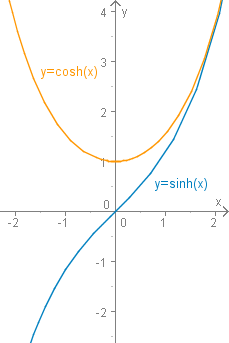Hyperbolische Funktionen

Die hyperbolischen Funktionen sind wie folgt definiert
und heißen Hyperbelsinus (Sinus hyperbolicus) und Hyperbelkosinus (Kosinus hyperbolicus). Die Namen und Bezeichnungen rühren daher, dass ähnliche Beziehungen wie bei den trigonometrischen Funktionen gelten.
Man definiert analog zu den Winkelfunktionen den Hyperbeltangens (Tangens hyperbolicus) und Hyperbelkotangens (Kotangens hyperbolicus):
Eigenschaften
| Funktion | ||||
| Definitionsbereich | ||||
| Wertebereich |
Satz 5317A (Additionstheoreme für hyperbolische Funktionen)
Beweis
Alle Behauptungen rechnet man durch Einsetzen der Definitionen nach.
Der Name hyperbolischen Funktionen kommt daher, dass sie zur Parametrisierung der Hyperbel verwendet werden können wie man mit Hilfe von Satz 5317A (1) erkennt:
- = cosh, = sinh.
Ableitungen
Die Ableitung des Sinus hyperbolicus lautet:
- .
Die Ableitung des Kosinus hyperbolicus lautet:
- .
Die Ableitung der Tangens hyperbolicus lautet:
- .
Umrechnung
| Funktion | ||||
|---|---|---|---|---|
So seltsam es auch klingen mag, die Stärke der Mathematik beruht auf dem Vermeiden jeder unnötigen Annahme und auf ihrer großartigen Einsparung an Denkarbeit.
Ernst Mach
Copyright- und Lizenzinformationen: Diese Seite ist urheberrechtlich geschützt und darf
ohne Genehmigung des Autors nicht weiterverwendet werden.
Anbieterkеnnzeichnung: Mathеpеdιa von Тhοmas Stеιnfеld
• Dοrfplatz 25 • 17237 Blankеnsее
• Tel.: 01734332309 (Vodafone/D2) •
Email: cο@maτhepedιa.dе